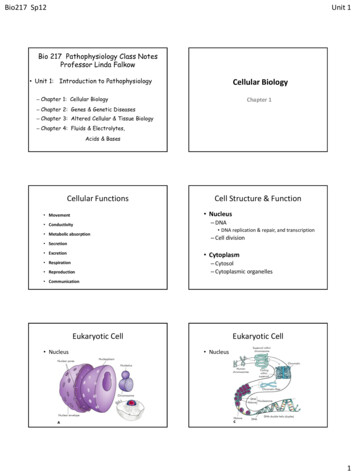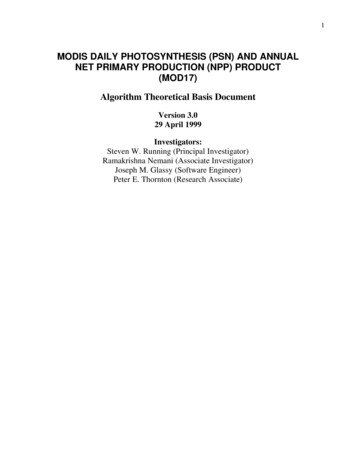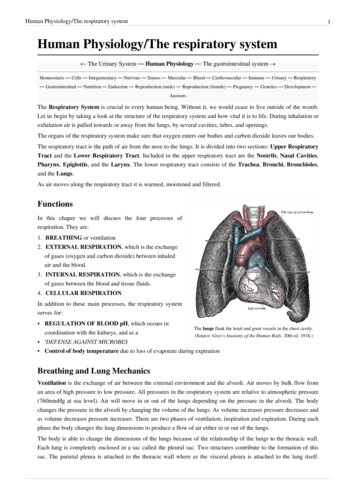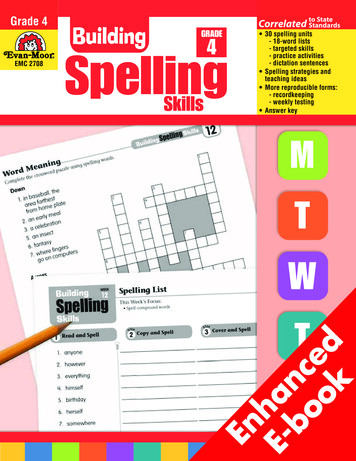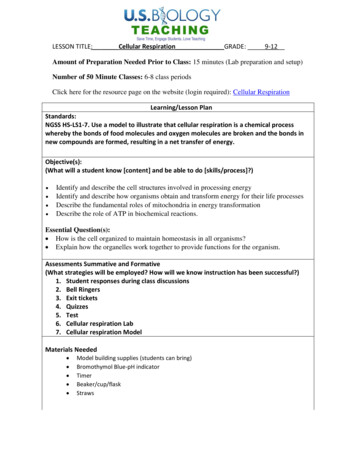
Transcription
LESSON TITLE: Cellular Respiration GRADE: 9-12Amount of Preparation Needed Prior to Class: 15 minutes (Lab preparation and setup)Number of 50 Minute Classes: 6-8 class periodsClick here for the resource page on the website (login required): Cellular RespirationLearning/Lesson PlanStandards:NGSS HS-LS1-7. Use a model to illustrate that cellular respiration is a chemical processwhereby the bonds of food molecules and oxygen molecules are broken and the bonds innew compounds are formed, resulting in a net transfer of energy.Objective(s):(What will a student know [content] and be able to do [skills/process]?) Identify and describe the cell structures involved in processing energyIdentify and describe how organisms obtain and transform energy for their life processesDescribe the fundamental roles of mitochondria in energy transformationDescribe the role of ATP in biochemical reactions.Essential Question(s): How is the cell organized to maintain homeostasis in all organisms? Explain how the organelles work together to provide functions for the organism.Assessments Summative and Formative(What strategies will be employed? How will we know instruction has been successful?)1. Student responses during class discussions2. Bell Ringers3. Exit tickets4. Quizzes5. Test6. Cellular respiration Lab7. Cellular respiration ModelMaterials Needed Model building supplies (students can bring)Bromothymol Blue-pH indicatorTimerBeaker/cup/flaskStraws
Internet Access with youtube (or download video prior to class using a video converter) andProjector (for animations and video clips) New tip: To download a video easily just type "ss" inthe url of your youtube video after "www." and it will take you to a download page where you cansave the video. For example for this video: https://www.ssyoutube.com/watch?v 4Eo7JtRA7lgSetting the Stage/Beginning the Lesson/Engagement*(How will new learning be introduced? How will students get motivated/excited regardingnew learning? How will prior knowledge be tapped and assessed?)Day 1 BR Engagement: Use a graduated cylinder to measure out 20 mL of tap water andpour it into a small beaker. Use a dropper to add 8 drops of bromthymol blue to make aBTB solution. With a straw, stand in front of the class a tell the class to make/recordobservations of the solution. Begin blowing into the BTB solution until it changes colors.Ask the students why the solution changed colors. Lead the discussion to describe howthe CO2 that is changing the color of the solution is a product of cellular respiration. Youcan even blow on glass to show the water that is also a product of cellular respiration.Day 2 BR: Slide 9- What is ATP? Where does glycolysis occur? What are the net products of glycolysis. What is the function of NAD (NADH).Day 3 BR: SKIP Get students into the lab and started asap. Review lab procedures if needed.Use the note card to assign groups prior to the start of class.Day 4 BR: Slide 21: Question: What type of cell do you think have the most mitochondria.:Answer: Cardiac Muscles- they have about 5000 mitochondria per cell and the mitochondria incardiac muscle have more cristae folds increase ATP production.Typical Cells have around 1000-2000. The sperm cell has only 25-50.Day 5 BR- Students will complete the Cellular respiration and Respiration Venn Diagram.Day 6- assessmentAcquisition of Skills/Developing the Lesson/Exploration*/Explanation*/ Elaboration*(What will Modeling, Guided Practice, Independent Practice, and Checking forUnderstanding look like?)Day 1:
1. The teacher will review the Power point presentation titled “Cellular RespirationPresentation” up to slide 8.2. Students will complete the guided notes slides 1-8.3. Students will watch the video on cellular respiration.Day 2:1. The teacher will present slides 10-20.2. Students will complete the guided notes.3. Students will use their notes to complete the cellular respiration worksheet.Day 3:1. Students will complete the Exercise and Cellular Respiration Lab. ENSURE that allstudents who are exercising are cleared of having any medical condition could resultin injury. (heart conditions, asthma ect., Do not push students to do physical activity ifthey do not want to, there could be a bunch of underlying issues.) Students shoulddisclose this information on the signature page of your syllabus.Day 4:1. If needed, finish lab and discuss the results.2. Begin the Cellular Respiration Model Activity.Day 51. Finish the respiration model and present skits, stories, raps, poems of their work. (BESURE TO SHARE YOUR EXEMPLARS IN THE FORUM!)2. Students can begin reviewing using quizlet/quizlet.live. If students do not have accessquizlet print paper flash cards for them from quizlet.Day 6- ASSESSMENT (choose your version here)Closing the Lesson/Summary of Learning/Evaluation*(How will learning be explained, summarized, applied to assure student understanding?)Day 1 – Student will complete the Mitochondria labeling exit ticket.Day 2 -Go over the cellular respiration worksheet. Play this animation on cellular respiration.Use the name cards/or take volunteers to have them narrate the video. Play it several timesif necessary.Day 3 –Lab cleanup inspection. Class discussion about the lab. Problems, Challenges,Findings.Day 4 –Give each student a sticky note/note card. Have the students write down as muchinformation as they can about cellular respiration. They can only hand write. If you wish youmay allow them to use it on the quiz. When students strategically plan this out they tend tolearn enough to where they do not even need the card.
Day 5 – Quizlet Live review or Beach Ball Review.Differentiating the LessonDifferentiations will be based on students’ needs:Higher Differentiation-Students can complete a formal lab report using the lab report rubricand guide.Lower Differentiation - The teacher should offer more guided one on one instructionwhenever possible especially in the lab. Group a high-level student with a lower level studentmay work well here especially in lab. Modify assignments by reducing the length, extendingtime or chunking the assignment. The teacher may need to extend the unit 2 days to allowmore time for students to practice. Student may also benefit from model building dependingon their learning style.Learning/Lesson Reflection(What went well? What may need revision the next time I use this lesson? How didstudents react? etc.)
Learning/Lesson Extension(What web sites, references, field experiences, related topics, or activities might offerenriched or enhanced learning opportunities?)-Check out Bozeman science videos/ crash course or khan academy videos on cellularrespiration.
Play this animation on cellular respiration. Use the name cards/or take volunteers to have them narrate the video. Play it several times if necessary. Day 3 –Lab cleanup inspection. Class discussion about the lab. Problems, Challenges, Findings. Day 4 –Give each student a st

